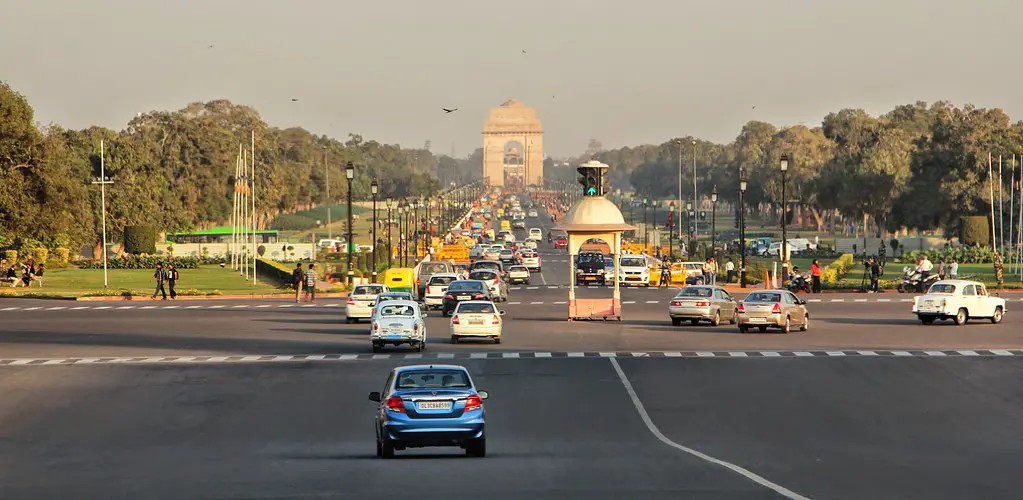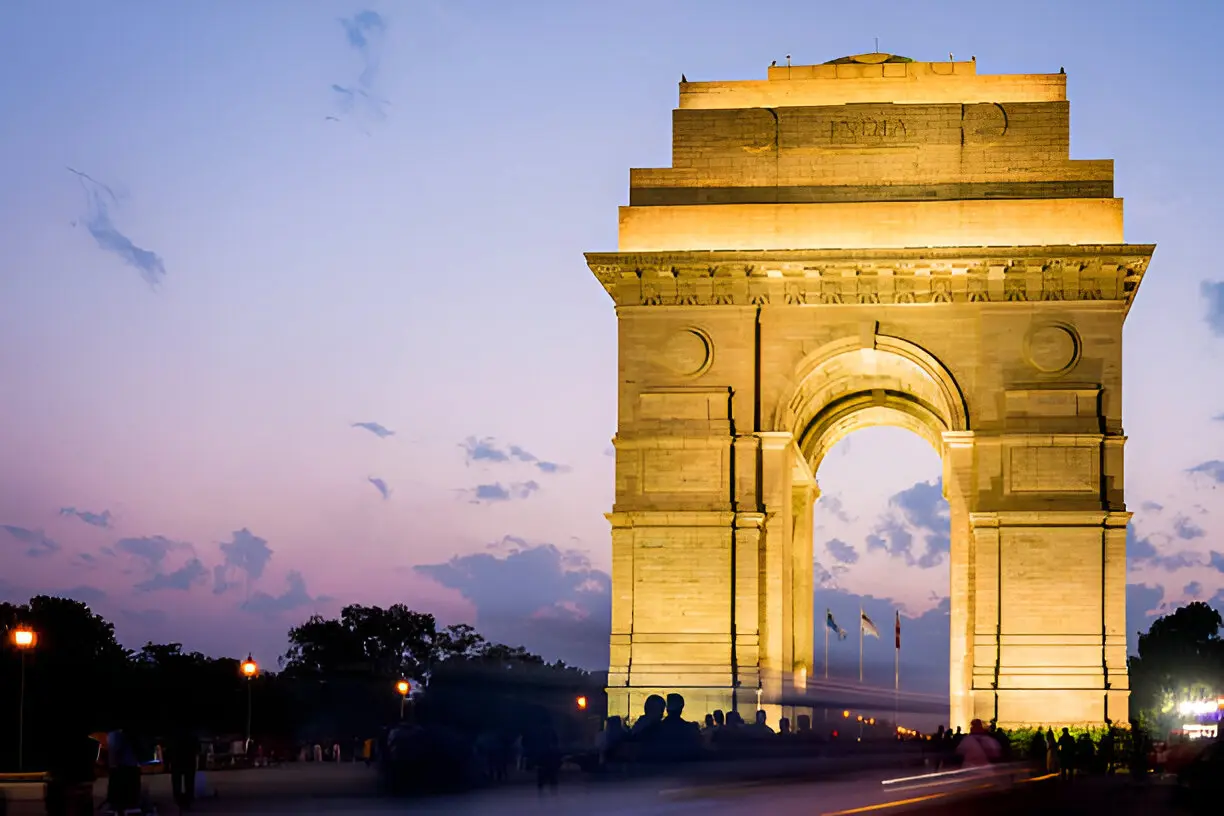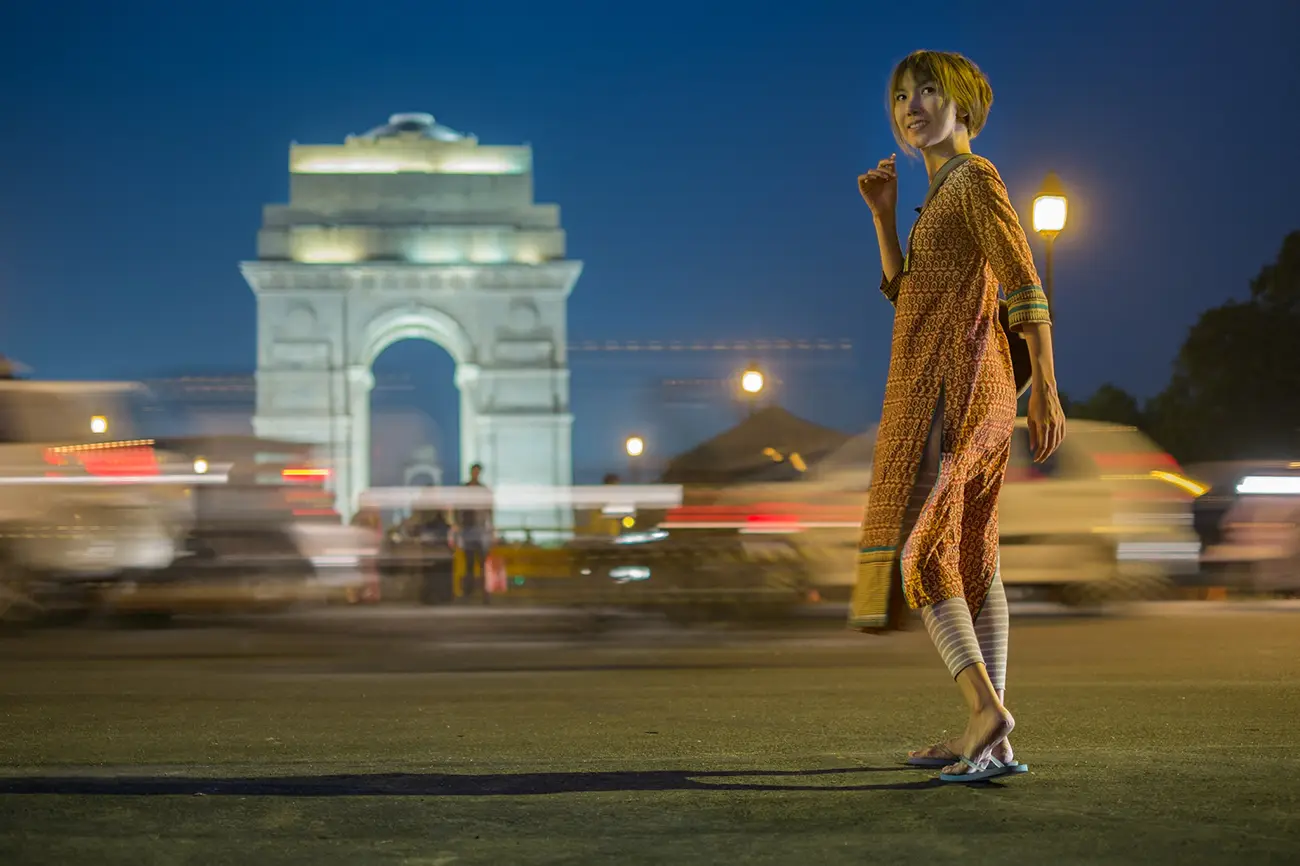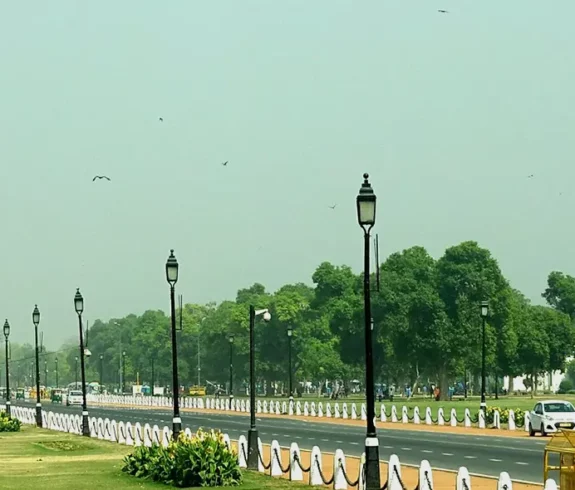India Gate, Delhi, is a famous war memorial arch and city landmark. It was built to honor the memory of soldiers who died in World War I and the Third Anglo-Afghan War. The monument stands in the heart of New Delhi on a broad open plaza. Its warm sandstone color and the green lawns make it a peaceful beauty. India Gate is brightly lit at night, spreading a luminous shine through the dark sky. The arch’s central location at the end of Kartavya Path (formerly Rajpath) makes it easy to find. It sits near the President’s House and key government buildings, a truly iconic city symbol.

Historical Significance & Purpose
The British built the India Gate as a memorial to their Indian army soldiers. It is dedicated to about 84,000 soldiers of the British Indian Army who died in World War I and the Third Anglo-Afghan War. The names of around 13,300 of these soldiers (mostly Indian, some British) are engraved on its stone walls. This means that the names of every fallen soldier are recorded on the gate as a permanent tribute.
Sir Edwin Lutyens, the primary architect of New Delhi, crafted the design for the archway. Lutyens chose a simple, classical design with broad, clean lines. India Gate’s shape is often compared to the Arc de Triomphe in Paris. The gate is built of yellow and red sandstone, rising about 42 meters (138 feet) tall. Each side of the arch has large open portals framed by plain stone surfaces, giving it a grand and solemn look.
Construction of India Gate began in 1921 when the Duke of Connaught laid the foundation stone. It took about ten years to complete. The memorial was officially unveiled in 1931 by Lord Irwin, the Viceroy of India. At that ceremony, Lord Irwin said the monument would inspire future generations to remember the bravery and sacrifice of the soldiers. An inscription on the arch reads, “To the dead of the Indian Armies who fell and are honored…” and lists the battlefields of World War I. 1914 and 1919 are carved in Roman numerals on the arch, marking the war.
Originally called the All India War Memorial, the arch became known simply as India Gate after independence. After India became a republic, the gate took on new meaning. In 1971, a black marble monument named the Amar Jawan Jyoti (Flame of the Eternal Soldier) was placed beneath the arch.
This memorial has an inverted rifle and a soldier’s helmet on a pedestal, with an eternal flame burning. It honors the Indian soldiers who died in the 1971 Indo-Pakistan War. Annually, the Prime Minister places a wreath at the Amar Jawan Jyoti on Republic Day to honor India’s unidentified fallen warriors. In these ways, India Gate remains a powerful tribute to the nation’s heroes.

Architectural Description & Surroundings
India Gate is built mainly of sandstone. The stones come from the region near Bharatpur and have warm yellow and red tones. The gate sits on a raised red sandstone base and rises in plain, wide steps up to a prominent cornice. Its overall shape is a tall, oblong archway. The two long sides of India Gate each have a grand 9.1-meter-wide (30-foot) arch opening, while the shorter sides have smaller archways that are partly filled in at the bottom. The top of the gate is crowned with a carved sunburst design above the prominent cornice. The words “INDIA” and the dates 1914–1919 (in Roman numerals) are engraved on the top sides of the gate.
Standing near India Gate, you can see the details of the design. The word INDIA is carved in large letters at the top of the arch on all four sides. Below, on the east and west faces, are the years 1914–1919.
The ceiling inside the central archway is neatly coffered (with recessed panels). Along the sides, simple fluted pillars and moldings add a bit of decoration. The style is classical and intentionally free of religious symbols. There are no crosses or statues of gods or kings on India Gate itself (the king’s statue was in a separate canopy). The result is a memorial that feels universal and calm rather than ornate.
A small domed canopy on four columns is about 150 meters east of the gate. It was built simultaneously to hold a statue of King George V (who had planned the New Delhi capital). After India’s independence, the statue was removed, and the canopy now stands empty. It is an interesting piece of the site’s history, showing the colonial style of Lutyens with its curved dome and red sandstone.
India Gate sits at the eastern end of Kartavya Path, the grand boulevard that stretches west toward Rashtrapati Bhavan (the President’s House). The surroundings are very open and symmetrical. On each side of Kartavya Path are long green lawns and flowerbeds. These lawns have paths and lined trees. After recent renovations of the avenue, long shallow water channels now run along the center of the lawns between the paths.
These canals can hold water like a reflecting pool and are filled for events. They are also part of a rainwater drainage system. On most days, these channels are dry, but fountains and sprinklers, from time to time, make them gleam. A large central fountain area lies just west of the gate on the lawn axis.
The gate is centered in a large circular plaza (often called the India Gate circle). From this roundabout, six roads radiate out in all directions. Two roads run west toward the President’s House and Parliament—two head north and south past the North and South Block government offices. Two more go east into the city. Because of this star-like road layout, traffic flows in a big circle around India Gate. Pedestrians can use crosswalks and pedestrian signals to reach the lawns from each road. At night, streetlights illuminate the entire plaza, making the monument easy to approach even after dark.

The Atmosphere and Visitor Experience
India Gate is both a memorial and a favorite public gathering spot. During the day, many locals and tourists visit the site. Families often come to picnic on the lawns. Children run around playing games or fly kites on the grassy fields. You will see groups of friends sitting together on blankets, chatting, or even having a small meal. Shaded by the tall trees along the sides, some visitors sit reading or relaxing with their families. Schoolchildren often visit in the morning during history lessons since India Gate is closely tied to India’s past. The mood during the day is calm and open.
When the sun goes down, India Gate becomes lively differently. At twilight, the arch and pathways are lit by golden spotlights. The warm glow on the sandstone makes the monument look especially striking. From about 6 PM onward, people start to fill the lawns and paths again. Young couples, photographers, and families come out to see the lights. The monument is very popular at night for pictures—many visitors take photographs under the arch and of the long view down Kartavya Path. The area can feel festive on weekends and holidays, with the relaxed sounds of evening chatter, music from nearby vendors, and laughter drifting in the air. Despite the crowds, the atmosphere stays friendly and open.

A big part of the experience at India Gate is the street food. On the lawn walkways, especially in the evening, dozens of small carts and stalls sell popular Indian snacks. You can try pani puri (crispy hollow balls filled with spicy flavored water), bhel puri (crispy puffed rice with chutneys), and other chaats made of fried dough, potatoes, yogurt, and chutney.
Vendors roast corn on the cob or sell hot samosas (fried pastry pockets) and masala chai (spiced tea). On warm days, people grab cool coconut water or scoops of kulfi (Indian ice cream). Sampling these local treats is part of the fun of visiting India Gate. Many people will sit on the benches or the grass, enjoying a snack while gazing at the illuminated arch.
For a quieter visit, the best time is early morning. The area is peaceful and nearly empty from sunrise (around 6 AM) until about 8 AM. The air is cool, and you might see joggers along Kartavya Path or a few locals doing yoga on the lawns. The light of dawn makes the sandstone arch glow softly. This early hour allows one to experience the monument in stillness, reflecting on its meaning without crowds. Conversely, the lights go off late at night, after 11 PM, and the park closes to pedestrians, returning to calm darkness until the next morning.
It is important to remember that India Gate is a war memorial. Visitors should be respectful. People generally keep their voices low near the arch and around the eternal flame of the Amar Jawan Jyoti. Loud partying or music is not allowed. You should not climb on the monument or disturb the engraved names. Always place your litter in the designated bins or carry it with you. If you pass by military guards or police, offer a polite greeting rather than taking close photos of them. In short, treat India Gate as a park and a shrine – enjoy the space, but honor what it stands for.
National Significance and Events
India Gate has a special role in India’s national ceremonies. The biggest event is Republic Day (January 26) each year. On that day, the Prime Minister and other top leaders formally visit India Gate in the morning. The Prime Minister places a wreath at the Amar Jawan Jyoti, honoring the unknown soldiers. After this tribute, the grand Republic Day parade begins along Kartavya Path. The military band and marching troops often pass near India Gate, with the huge arch lit up in patriotic colors. A 21-gun salute is performed to pay tribute to the soldiers. From a distance, India Gate is an imposing backdrop to these celebrations.
Independence Day (August 15) and other patriotic occasions are also linked to India Gate. On such days, ceremonial guards might stand at attention by the eternal flame. People often place flowers at the monument or hoist the national flag nearby. India Gate’s presence reminds everyone of India’s freedom struggle and those who gave their lives for it.
Beyond official ceremonies, India Gate is used by citizens for public gatherings. It has become a common meeting point for peaceful rallies or vigils. After a tragic event or to commemorate a cause, people might hold candlelight gatherings near the arch or the fountain. For example, candlelight vigils have been held here after attacks or disasters or to remember important figures. India Gate’s open, neutral location makes it a symbol of public expression. Crowds can gather on the lawns and steps to hold banners or talk to the press. Through these peaceful assemblies, India Gate serves as a symbol of unity and free speech.
India Gate also appears frequently in media images of India. Its silhouette is on postcards, newspapers, and websites when Delhi is shown. To many Indians, seeing India Gate in an image evokes national pride. Visitors from abroad often say the monument gives a sense of India’s history and resilience. In India and worldwide, the arch of India Gate is seen as a visual icon of the capital city. This broad recognition adds to the gate’s national significance as a living memorial and a gathering spot.
Just east of India Gate lies the National War Memorial, opened in 2019. This newer memorial honors soldiers who died in India’s wars after independence. It has its eternal flame and a garden of names. Because the two memorials are so close, many visitors take the time to see both. Walking from India Gate to the National War Memorial is only a few minutes. Together, they cover India’s entire military history and pay tribute to heroes of all eras.
Why Visit India Gate
India Gate, Delhi, is a must-see landmark when you visit New Delhi. It offers a combination of history, beauty, and public life. As a historic monument, it tells the story of India’s soldiers and wars. You can read the inscriptions and names to understand their sacrifices. As a public park, it offers shade, fresh air, and wide-open space in the city. Walking through the arch, you can feel connected to India’s past, even while enjoying a casual outing.
The site appeals to all kinds of visitors. History buffs will appreciate the meaning of the memorial and its connection to World War I. Architecture lovers can admire Lutyens’ classical design and the monument’s proportions. Photographers will love capturing the arch in daylight or lit at night. The long, straight view down Kartavya Path toward Rashtrapati Bhavan is especially picturesque. Families and kids can play on the lawns or visit the Children’s Park nearby. For couples and friends, sitting on a bench at sunset with local snacks in hand is a delightful experience.
Visiting the India Gate is very easy. There is no entrance fee or ticket – the gate and its gardens are open 24/7. You can drop by any time and stay as long as you like. Visiting around sunset to see the lights is especially lovely, but even a quick daytime visit is rewarding. Because India Gate is centrally located, you can combine it with other nearby attractions. For instance, the National Museum, the Gandhi Memorial, or an official tour of Rashtrapati Bhavan and Parliament House can all be done on the same trip. Connaught Place, an extensive shopping and dining area, is only a short drive away, giving easy options for food or shopping after your visit.
India Gate also connects you to local life. You will see Delhiites strolling, students studying, and families having fun on the lawns. Street food sellers provide a taste of Delhi’s flavors. In this way, a visit to India Gate is not just an outing to a monument but an immersion into the city’s everyday vibe. The combination of solemn history and lively park makes India Gate unique. It truly honors the heroes of the past while embracing the life and energy of the present.
Practical Information
Location:
Central Delhi at the eastern end of Kartavya Path (formerly Rajpath). India Gate lies between the Delhi District and the New Delhi District. Nearby landmarks include Rashtrapati Bhavan (west), the National War Memorial (east), and Connaught Place (northwest).
How to Get There:
The Delhi Metro is very convenient. The nearest stations are Khan Market (Violet Line) and Central Secretariat (Yellow and Violet Lines). India Gate is about a 10–15 minute walk or a short auto-rickshaw ride from those stations. Mandi House station (Blue and Violet Lines) is also nearby. Several city buses stop near India Gate; look for routes via Parliament, Connaught Place, or Akashvani Marg. Auto-rickshaws and taxis will drop you right at the entrance to the roundabout. Tell the driver, “India Gate,” and they will know how.
Entry Fee:
None. Entry is free and open to all visitors. No ticket is required at any time. You can enter the lawns and see the monument without charge.
Opening Hours:
India Gate and its grounds are open 24 hours a day. People can visit at any time. However, the monument is best appreciated in daylight or after dark when it is illuminated. The floodlights are usually switched on at sunset (around 6–7 PM) and turned off around 11 PM. Maintenance or event closures are rare but may happen briefly on official occasions. For the most peaceful visit, try early morning (around sunrise) or later in the evening (after 8 PM) on a weekday.
Photography:
Allowed. Tourists frequently take photos of India Gate, especially at night or with crowds. The monument is a very popular photo spot. You can use cameras and smartphones anywhere. Due to security rules, drones and kites are not permitted in the area, so flying aerial cameras is banned. Also, be mindful of others when taking pictures. Overall, photos are welcome, and many people treasure images of the India Gate.
Facilities:
There are basic facilities around India Gate. Public restrooms (pay toilets) are located at the park’s edge or near some food stalls. Drinking water fountains and sealed water dispensers are available on the walkways. Benches and seating areas are found along the lawns. Trash bins are placed around the park – please use them to keep the lawns clean. Vendors sell snacks, drinks, and souvenirs in the evenings. There is no large parking lot at India Gate itself; however, cars can stop briefly at the roundabout for drop-off. Nearby paid parking is available on surrounding streets, or you can park at Connaught Place and walk. The lawns and paths are flat and mostly paved, making it easy for wheelchairs or strollers to move around. The whole place is guarded by security personnel, and medical help is available if needed. Finally, if you need more shopping or dining options, Connaught Place is just 2 km away with many restaurants and stores.
Why Visit:
India Gate is a historic and iconic landmark that honors India’s heroes. It is also a living park where city life thrives. The architecture is impressive and photogenic, especially at night. Being centrally located, it’s easy to reach by metro or taxi. The monument itself is free to enter and walk around. You can pay respects in silence or join locals picnicking on the lawns. Either way, India Gate leaves a lasting impression of India’s past and present.
